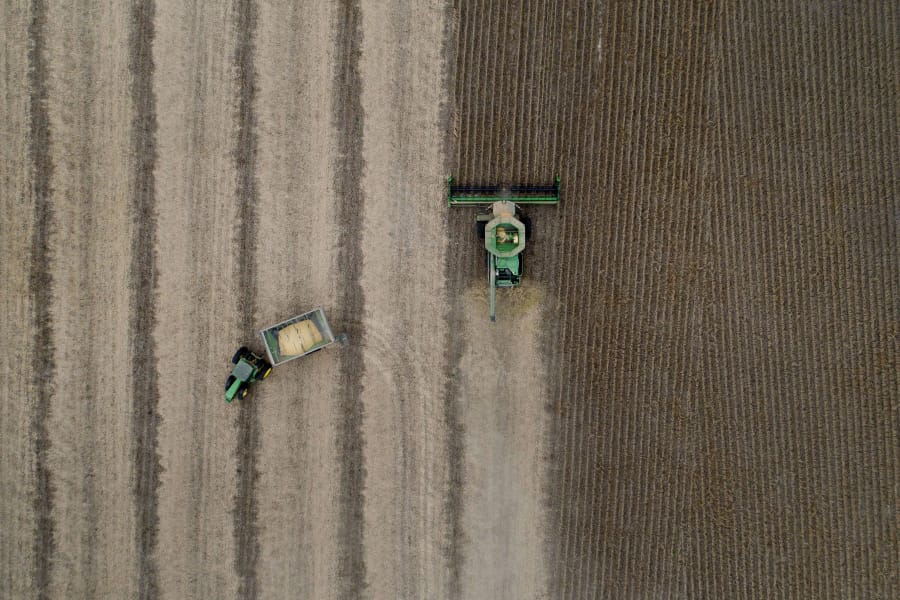U.S. farmers are pleased that Donald Trump and Xi Jinping agreed to a trade truce, but they’re not rejoicing just yet. That won’t come until they see ships full of their soybeans headed to China.
“The bottom line is: What are the details?” said Sharon Covert, co-owner of a farm in North Central Illinois with 500 acres of soybeans. She’s one of several farmers interviewed Monday with a wait-and-see attitude on the truce.
David Rodibaugh, a soybean grower in Rensselaer, Indiana, was happy to hear about the truce, he said, but was “taking it with a grain of salt” until he sees actual sales. He and scores of other U.S. farmers have stashed away more bushels than usual to wait out the trade war and sell at higher prices.
Midwest soybean growers have been caught in the crossfire as the U.S. and China argue over intellectual property, steel and cars. Amid the tit-for-tat tariffs, China shunned U.S. soybeans, buying instead from Brazil and Argentina. That upset trade flows developed over decades, and dropped U.S. prices at a time when farmers were reaping a record crop.
“I want to see ships sent to China with U.S. beans on them so we can avoid losing market share,” Rodibaugh said in a telephone interview.
Cryptic signs
The signs have been cryptic at best. After the dinner in Argentina, the White House said China will begin buying commodities immediately from the U.S. again without any details. Then, Trump followed up with a tweet saying that farmers would be “very BIG and FAST” beneficiaries.
U.S. Agriculture Secretary Sonny Perdue said on Monday he expects Chinese crop purchases to resume around the first of the year, probably starting with the purchase of soybeans. But China has yet to formally respond, and there’s still no sign of any easing in the 25 percent retaliatory tariff that China levies on imports of American soybeans.
“I see little incentive for Chinese commercial crushers to buy U.S. soybeans right now unless the 25 percent tariff is lifted, or U.S. farmers cut prices even more,” said Monica Tu, an analyst at researcher Shanghai JC Intelligence Co. Any purchases made in the current conditions would probably be to supply state inventories, she said.
China indicated it could reimburse the cost of the 25 percent tariff if the cargoes are imported for state reserves, according to people familiar with the matter.
The different statements issued by the U.S. and China on the outcome of the meeting between President Trump and his counterpart highlight how much needs to be achieved in the next three months if U.S. soybean farmers are to find any kind of solace from rising stockpiles.
Meanwhile, U.S. farmers remain cautiously hopeful. “It means a lot for North Dakota farmers if we can get trains rolling and ships out of the Pacific Northwest,” said soybean grower Matt Gast, who was harvesting corn while keeping an eye on futures prices in his combine. “We’ve got beans. Let’s get them rolling.”
Gast and his family, which grows several thousand acres of corn and soybeans near Valley City, North Dakota, are storing about 60 percent of their soybean harvest this year compared to 10 to 15 percent in the past as the drop in exports drove prices lower.
Farmers such as Covert and Rodibaugh want to know if China’s retaliatory tariffs on soybeans and other U.S. agricultural products will continue? What will China’s biotech and phyto-sanitary regulations look like going forward? Most importantly, will the country start buying again from the U.S.?
Agricultural heavyweight Cargill Inc. said the U.S. may have missed a bulk of the window to sell soy to China. The country usually buys three months ahead, Dave Baudler, managing director of North America grain for Cargill, said at a conference in St. Louis on Monday. China usually buys heavily from the U.S. as it harvests crops between September and December and then shifts to South America starting in January and February.



